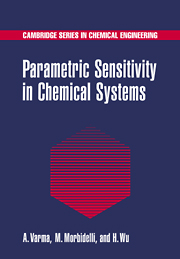Book contents
- Frontmatter
- Contents
- Preface
- 1 Introduction
- 2 Introduction to Sensitivity Analysis
- 3 Thermal Explosion in Batch Reactors
- 4 Runaway in Tubular Reactors
- 5 Parametric Sensitivity in Continuous-Flow Stirred Tank Reactors
- 6 Runaway in Fixed-Bed Catalytic Reactors
- 7 Parametric Sensitivity and Ignition Phenomena in Combustion Systems
- 8 Sensitivity Analysis in Mechanistic Study and Model Reduction
- 9 Sensitivity Analysis in Air Pollution
- 10 Sensitivity Analysis in Metabolic Processes
- Author Index
- Subject Index
8 - Sensitivity Analysis in Mechanistic Study and Model Reduction
Published online by Cambridge University Press: 04 May 2010
- Frontmatter
- Contents
- Preface
- 1 Introduction
- 2 Introduction to Sensitivity Analysis
- 3 Thermal Explosion in Batch Reactors
- 4 Runaway in Tubular Reactors
- 5 Parametric Sensitivity in Continuous-Flow Stirred Tank Reactors
- 6 Runaway in Fixed-Bed Catalytic Reactors
- 7 Parametric Sensitivity and Ignition Phenomena in Combustion Systems
- 8 Sensitivity Analysis in Mechanistic Study and Model Reduction
- 9 Sensitivity Analysis in Air Pollution
- 10 Sensitivity Analysis in Metabolic Processes
- Author Index
- Subject Index
Summary
Detailed or rigorous kinetic models, consisting of a large number of elementary reactions, are used increasingly to simulate complex reacting processes. An example is given in Chapter 7, where, using detailed kinetic models, we predicted the explosion limits of hydrogen-oxygen mixtures. The main advantage of a detailed versus a simplified or empirical kinetic model is its wider operating window. In other words, detailed models generally describe the kinetics of complex processes for a larger range of operating conditions, while simplified models can be used only for specific conditions. Moreover, detailed models are able to provide proper estimation of the radical concentrations involved in complex processes. Thus, detailed kinetic modeling is an important tool for the analysis and design of complex reacting systems.
A related aspect of detailed kinetic models is that, although they may provide satisfactory simulations of experimental results, their complexity often prevents the understanding of the key features of a process. For example, when using detailed kinetic models, it is often difficult to identify the main reaction paths in a complex reacting system.
Simplified kinetic models, on the other hand, offer several advantages in practical applications. A complex reacting (e.g., combustion) process typically involves a few hundreds of elementary reactions, and hence includes several hundred kinetic parameters. This is true not only for the combustion of complex fuels but also for simpler ones, such as hydrogen or methane. The computational effort associated with the application of complex kinetic models forces the introduction of very simple models to describe the transport processes in reactors where the reaction takes place (e.g., plug-flow or perfectly mixed).
- Type
- Chapter
- Information
- Parametric Sensitivity in Chemical Systems , pp. 247 - 286Publisher: Cambridge University PressPrint publication year: 1999



